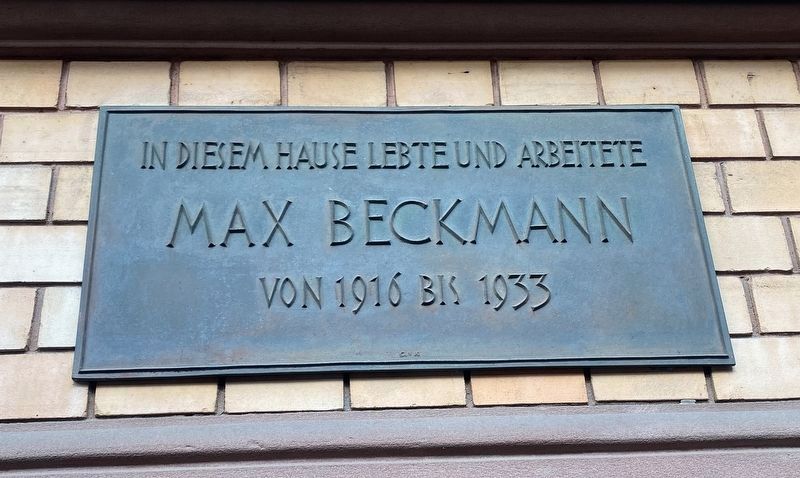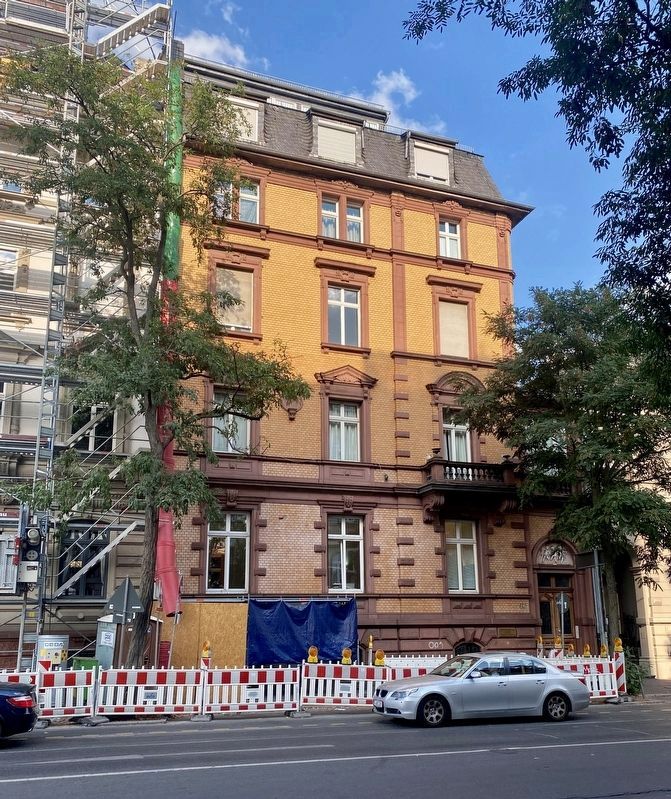Frankfurt am Main, Hesse, Germany — Central Europe
Max Beckmann
In diesem Haus lebte und arbeitete
Max Beckmann
von 1916 bis 1933
Max Beckman lived and worked in this building from 1916 to 1933.
Topics. This historical marker is listed in this topic list: Arts, Letters, Music. A significant historical year for this entry is 1916.
Location. 50° 6.309′ N, 8° 40.693′ E. Marker is in Frankfurt am Main, Hessen (Hesse). Marker is on Schweizer Straße, on the left when traveling south. Touch for map. Marker is at or near this postal address: Schweizer Straße 3, Frankfurt am Main HE 60594, Germany. Touch for directions.
Other nearby markers. At least 8 other markers are within walking distance of this marker. Wassilij Schukowski und Nikolaj Gogol / Vasily Zhukovsky and Nikolai Gogol (approx. 0.3 kilometers away); Historische Villa Metzler (approx. 0.3 kilometers away); Untermainbrücke / Lower Main Bridge (approx. 0.3 kilometers away); Ludwig Landmann (approx. 0.3 kilometers away); Eiserner Steg / The Iron Bridge (approx. half a kilometer away); Städtische Bühnen / Municipal Theatre Company - Memorial for Victims of the Nazis (approx. half a kilometer away); Rententurm, Fritz Unruh (approx. half a kilometer away); Spolien der Frankfurter Altstadt / Spolia from Frankfurt's historical city centre (approx. 0.6 kilometers away). Touch for a list and map of all markers in Frankfurt am Main.
Also see . . . Max Beckmann (Wikipedia).
Excerpt: "Max Carl Friedrich Beckmann (February 12, 1884 – December 27, 1950) was a German painter, draftsman, printmaker, sculptor, and writer. Although he is classified as an Expressionist artist, he rejected both the term and the movement. In the 1920s, he was associated with the New Objectivity (Neue Sachlichkeit), an outgrowth of Expressionism that opposed its introverted emotionalism. Even when dealing with light subject matter like circus performers, Beckmann often had an undercurrent of moodiness or unease in his works. By the 1930s, his work became more explicit in its horrifying imagery and distorted forms with combination of brutal realism and social criticism, coinciding with the rise of nazism in Germany....His fortunes changed with the rise to power of Adolf Hitler, whose dislike of Modern Art quickly led to its suppression by the state. In 1933, the Nazi government called Beckmann a "cultural Bolshevik" and dismissed him from his teaching position at the Art School in Frankfurt. In 1937 the government confiscated more than 500 of his works from German museums, putting several on display in the notorious Degenerate Art exhibition in Munich. The day after Hitler's radio speech about degenerate art in 1937, Beckmann left Germany with his second wife, Quappi, for the Netherlands."(Submitted on September 23, 2022.)
Credits. This page was last revised on September 23, 2022. It was originally submitted on September 23, 2022, by Andrew Ruppenstein of Lamorinda, California. This page has been viewed 52 times since then and 4 times this year. Photos: 1, 2. submitted on September 23, 2022, by Andrew Ruppenstein of Lamorinda, California.

